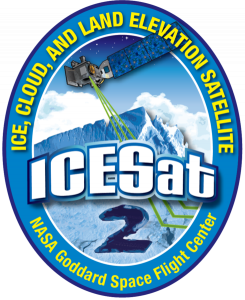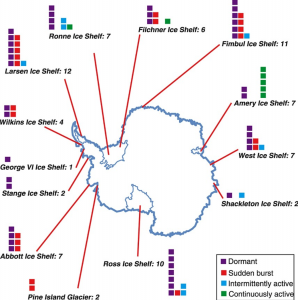
Ice, cloud and land elevation Satellite-2 (ICESat-2) Mission logo. ICESat-2 is a satellite carrying a laser altimeter instrument to measure the elevation of the changing ice sheets (and everywhere else on Earth too).
Antarctic Ice Shelf Rifts
Antarctic ice shelves count roughly 90 in number, circle the entire continent, and their combined area is similar to the entire Greenland Ice Sheet. Their expansive presence, subjected to changes in the ocean and atmosphere, makes them the primary sources of ice mass loss from Antarctica. This loss occurs via basal melting at the ice-ocean interface and iceberg calving.
Of the two, iceberg calving is least-well understood, and predicting retreat remains a significant challenge. Ice shelf rifts are through-cutting fractures in ice shelves. Rifts serve as eventual calving boundaries for icebergs and their behavior can be monitored for years to decades. Calving, and in some cases total collapse, is driven by accelerated rift propagation. Understanding future SLR (IPCC, 2021) depends on our understanding of ice shelf rift propagation.
A few years ago, we studied how different rifts around the Antarctic continent behaved (Walker et al., 2013).

Antarctic ice shelf locations and categories of rift propagation observed in Walker et al., JGR (2013). Each block denotes a rift, and the color of the block denotes the type of rift activity observed between 2002-2012.
Now, as part of NASA's Ice, cloud and land elevation Satellite-2 (ICESat-2) Mission Science Team, I work with Drs. Brad Lipovsky and Ashley Morris at the University of Washington and collaborator Dr. Oliver Marsh (British Antarctic Survey) to automatically map these rifts using laser altimetry.
ICESat-2 offers an unprecedented opportunity to understand the ways in which ice shelf rifts initiate, propagate, and ultimately lead to the tabular calving events that are one of the largest sources of ice mass flux for the Antarctic Ice Sheet.
So far, we have analyzed ICESat-2 data along a rift called the Halloween Crack (HC) in the Brunt Ice Shelf (BIS). The HC was instrumented with several surface GPS sites which allow for a close accounting of the processes that occur along an active rift. This case study on the BIS illuminates the interactions between ice shelf fracture processes while serving as a validation experiment for future ice sheet-wide rift studies.